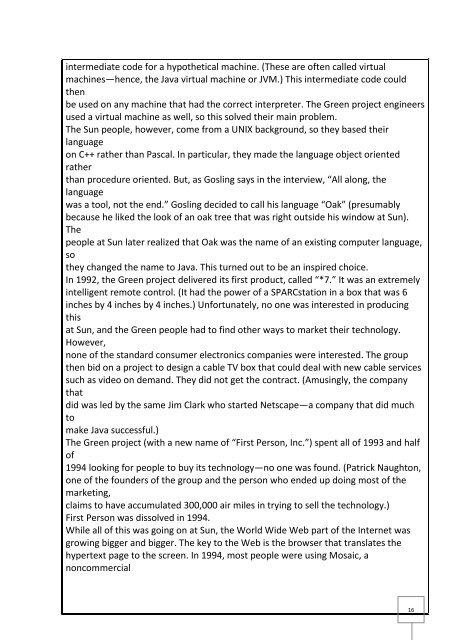Mini Project - DSpace at CUSAT - Cochin University of Science and ...
Mini Project - DSpace at CUSAT - Cochin University of Science and ...
Mini Project - DSpace at CUSAT - Cochin University of Science and ...
Create successful ePaper yourself
Turn your PDF publications into a flip-book with our unique Google optimized e-Paper software.
intermedi<strong>at</strong>e code for a hypothetical machine. (These are <strong>of</strong>ten called virtual<br />
machines—hence, the Java virtual machine or JVM.) This intermedi<strong>at</strong>e code could<br />
then<br />
be used on any machine th<strong>at</strong> had the correct interpreter. The Green project engineers<br />
used a virtual machine as well, so this solved their main problem.<br />
The Sun people, however, come from a UNIX background, so they based their<br />
language<br />
on C++ r<strong>at</strong>her than Pascal. In particular, they made the language object oriented<br />
r<strong>at</strong>her<br />
than procedure oriented. But, as Gosling says in the interview, “All along, the<br />
language<br />
was a tool, not the end.” Gosling decided to call his language “Oak” (presumably<br />
because he liked the look <strong>of</strong> an oak tree th<strong>at</strong> was right outside his window <strong>at</strong> Sun).<br />
The<br />
people <strong>at</strong> Sun l<strong>at</strong>er realized th<strong>at</strong> Oak was the name <strong>of</strong> an existing computer language,<br />
so<br />
they changed the name to Java. This turned out to be an inspired choice.<br />
In 1992, the Green project delivered its first product, called “*7.” It was an extremely<br />
intelligent remote control. (It had the power <strong>of</strong> a SPARCst<strong>at</strong>ion in a box th<strong>at</strong> was 6<br />
inches by 4 inches by 4 inches.) Unfortun<strong>at</strong>ely, no one was interested in producing<br />
this<br />
<strong>at</strong> Sun, <strong>and</strong> the Green people had to find other ways to market their technology.<br />
However,<br />
none <strong>of</strong> the st<strong>and</strong>ard consumer electronics companies were interested. The group<br />
then bid on a project to design a cable TV box th<strong>at</strong> could deal with new cable services<br />
such as video on dem<strong>and</strong>. They did not get the contract. (Amusingly, the company<br />
th<strong>at</strong><br />
did was led by the same Jim Clark who started Netscape—a company th<strong>at</strong> did much<br />
to<br />
make Java successful.)<br />
The Green project (with a new name <strong>of</strong> “First Person, Inc.”) spent all <strong>of</strong> 1993 <strong>and</strong> half<br />
<strong>of</strong><br />
1994 looking for people to buy its technology—no one was found. (P<strong>at</strong>rick Naughton,<br />
one <strong>of</strong> the founders <strong>of</strong> the group <strong>and</strong> the person who ended up doing most <strong>of</strong> the<br />
marketing,<br />
claims to have accumul<strong>at</strong>ed 300,000 air miles in trying to sell the technology.)<br />
First Person was dissolved in 1994.<br />
While all <strong>of</strong> this was going on <strong>at</strong> Sun, the World Wide Web part <strong>of</strong> the Internet was<br />
growing bigger <strong>and</strong> bigger. The key to the Web is the browser th<strong>at</strong> transl<strong>at</strong>es the<br />
hypertext page to the screen. In 1994, most people were using Mosaic, a<br />
noncommercial<br />
16
















